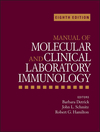Autoantibodies Directed against Erythrocytes in Autoimmune Hemolytic Anemia
Abstract
Immune-mediated hemolytic anemia can be broadly divided into two categories: alloimmune and autoimmune (1–4). Autoimmune hemolytic anemia may be further classified according to the immunoglobulin type of the autoantibody and its optimum temperature of reactivity (1–4). Warm autoimmune hemolytic anemia is due to IgG autoantibodies that bind to erythrocytes optimally at 37°C, while cold autoimmune hemolytic anemia is caused by IgM autoantibodies that preferentially react with red cells at low temperatures. A mixed-type autoimmune hemolytic anemia may occur when both warm IgG and cold IgM autoantibodies are implicated in clinical hemolysis. The rarest form of autoimmune hemolytic anemia, paroxysmal cold hemoglobinuria (PCH), is associated with IgG autoantibodies that are biphasic, sensitizing erythrocytes at lower temperatures and activating complement as the temperature increases to 37°C.



